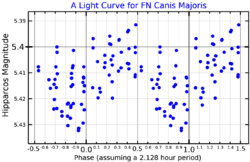Astronomy:FN Canis Majoris
| Observation data Equinox J2000.0]] (ICRS) | |
|---|---|
| Constellation | Canis Major |
| Right ascension | 07h 06m 40.76672s[2] |
| Declination | −11° 17′ 38.4396″[2] |
| Apparent magnitude (V) | 5.41[3] (5.69 + 7.04)[4] |
| Characteristics | |
| Spectral type | B0 III/IV[5] or B2 Ia/ab[6] |
| B−V color index | 0.033±0.004[3] |
| Astrometry | |
| Radial velocity (Rv) | +31.0±4.2[3] km/s |
| Proper motion (μ) | RA: −3.14±0.72[2] mas/yr Dec.: +3.32±0.55[2] mas/yr |
| Parallax (π) | 1.07 ± 0.61[2] mas |
| Distance | approx. 3,000 ly (approx. 900 pc) |
| Details | |
| Mass | 19.23±1.85,[7] 24.0±0.1,[8] 35.5±4.6[9] M☉ |
| Luminosity (bolometric) | 122,079,[7] 690,000[9] L☉ |
| Surface gravity (log g) | 3.59±0.11[9] cgs |
| Temperature | 26,850,[7] 33,600±1,840[9] K |
| Rotational velocity (v sin i) | 100±9[9] km/s |
| Age | 6.0±0.1[8] Myr |
| Other designations | |
| Database references | |
| SIMBAD | data |
FN Canis Majoris is a binary star[4] system in the southern constellation Canis Major, near the northern constellation border with Monoceros. It is dimly visible to the naked eye with a combined apparent visual magnitude of 5.41.[3] The system is located at a distance of approximately 3,000 light years from the Sun based on parallax, and is drifting further away with a radial velocity of +31 km/s.[3] It is a runaway star associated with the Sh 2-296 nebula in the CMa OB1 association, and has a conspicuous bow-shock feature.[6]
The brighter component is a visual magnitude 5.69[4] B-type star that has been assigned various stellar classification from B0 III/IV[5] to B2 Ia/ab,[6] suggesting it is an evolved state. In the past it was classified as a Beta Cephei type variable star[11] with an apparent magnitude that was measured varing between +5.38 and +5.42 over a period of 36.7 hours,[12] but is no longer considered to be one.[13] This is a massive star with estimates ranging from 19[7] to 36[9] times the mass of the Sun, and luminosity estimates of 122,079[7] to 690,000[9] times the Sun's luminosity. The magnitude 7.04[4] companion is located at an angular separation of 0.60″ from the primary at a position angle of 111°, as of 2003.[14]
References
- ↑ Rivinius, Th.; Stahl, O.; Štefl, S.; Baade, D.; Townsend, R. H. D.; Barrera, L. (July 2011). "The (B0+?)+O6 system FN CMa: a case for tidal-pulsational interaction?". Proceedings IAU Symposium 272: 543–544. doi:10.1017/S1743921311011380. Bibcode: 2011IAUS..272..543R.
- ↑ Jump up to: 2.0 2.1 2.2 2.3 2.4 van Leeuwen, F. (2007). "Validation of the new Hipparcos reduction". Astronomy and Astrophysics 474 (2): 653–664. doi:10.1051/0004-6361:20078357. Bibcode: 2007A&A...474..653V.
- ↑ Jump up to: 3.0 3.1 3.2 3.3 3.4 Anderson, E.; Francis, Ch. (2012). "XHIP: An extended hipparcos compilation". Astronomy Letters 38 (5): 331. doi:10.1134/S1063773712050015. Bibcode: 2012AstL...38..331A.
- ↑ Jump up to: 4.0 4.1 4.2 4.3 Eggleton, P. P.; Tokovinin, A. A. (2008). "A catalogue of multiplicity among bright stellar systems". Monthly Notices of the Royal Astronomical Society 389 (2): 869. doi:10.1111/j.1365-2966.2008.13596.x. Bibcode: 2008MNRAS.389..869E.
- ↑ Jump up to: 5.0 5.1 Tjin A Djie, H. R. E. et al. (August 2001). "The stellar composition of the star formation region CMa R1 - II. Spectroscopic and photometric observations of nine young stars". Monthly Notices of the Royal Astronomical Society 325 (4): 1441–1457. doi:10.1046/j.1365-8711.2001.04541.x. Bibcode: 2001MNRAS.325.1441T.
- ↑ Jump up to: 6.0 6.1 6.2 Fernandes, B. et al. (August 2019). "Runaways and shells around the CMa OB1 association". Astronomy & Astrophysics 628: 15. doi:10.1051/0004-6361/201935484. A44. Bibcode: 2019A&A...628A..44F.
- ↑ Jump up to: 7.0 7.1 7.2 7.3 7.4 Hohle, M. M. et al. (2010). "Masses and luminosities of O- and B-type stars and red supergiants". Astronomische Nachrichten 331 (4): 349–360. doi:10.1002/asna.200911355. Bibcode: 2010AN....331..349H.
- ↑ Jump up to: 8.0 8.1 Tetzlaff, N. et al. (January 2011), "A catalogue of young runaway Hipparcos stars within 3 kpc from the Sun", Monthly Notices of the Royal Astronomical Society 410 (1): 190–200, doi:10.1111/j.1365-2966.2010.17434.x, Bibcode: 2011MNRAS.410..190T
- ↑ Jump up to: 9.0 9.1 9.2 9.3 9.4 9.5 9.6 Zorec, J. et al. (November 2016). "Critical study of the distribution of rotational velocities of Be stars. I. Deconvolution methods, effects due to gravity darkening, macroturbulence, and binarity". Astronomy & Astrophysics 595: 26. doi:10.1051/0004-6361/201628760. Bibcode: 2016A&A...595A.132Z.
- ↑ "FN CMa". SIMBAD. Centre de données astronomiques de Strasbourg. http://simbad.u-strasbg.fr/simbad/sim-basic?Ident=FN+CMa.
- ↑ Hill, Graham (1967). "On Beta Cephei Stars: a Search for Beta Cephei Stars". The Astrophysical Journal Supplement Series 14: 263. doi:10.1086/190156. ISSN 0067-0049. Bibcode: 1967ApJS...14..263H.
- ↑ Lefèvre, L.; Marchenko, S. V.; Moffat, A. F. J.; Acker, A. (2009). "A systematic study of variability among OB-stars based on HIPPARCOS photometry". Astronomy and Astrophysics 507 (2): 1141–1201. doi:10.1051/0004-6361/200912304. ISSN 0004-6361. Bibcode: 2009A&A...507.1141L. https://hal.science/hal-03742152/file/aa12304-09.pdf.
- ↑ Stankov, Anamarija; Handler, Gerald (2005). "Catalog of Galactic β Cephei Stars". The Astrophysical Journal Supplement Series 158 (2): 193–216. doi:10.1086/429408. ISSN 0067-0049. Bibcode: 2005ApJS..158..193S.
- ↑ Mason, B. D. et al. (2014), "The Washington Visual Double Star Catalog", The Astronomical Journal 122 (6): 3466–3471, doi:10.1086/323920, Bibcode: 2001AJ....122.3466M.
 |


